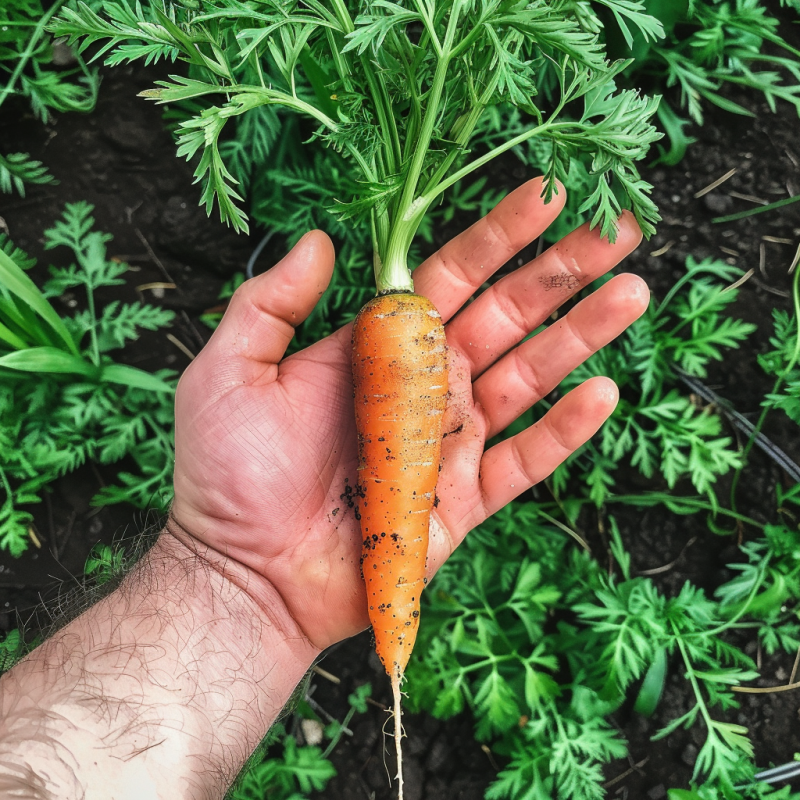Gardening enthusiasts often face the challenge of sowing carrot seeds without having dense plantings that require thinning. Thinning can be time-consuming and may disturb the delicate root systems of the plants. However, a simple yet effective hack can save you this trouble and ensure a hassle-free carrot harvest.
Gather Your Materials: You will need carrot seeds and dry coffee grounds. The coffee grounds should be completely dry to mix well with the seeds. Ensure you have the right tools, such as a small mixing bowl and a measuring cup.
Mix the Seeds and Coffee Grounds: Mix one part of carrot seeds with two parts of dry coffee grounds. This mixture helps in evenly distributing the seeds when you sow them. Using a small spoon, mix the seeds and coffee grounds thoroughly to ensure even distribution.
Prepare Your Garden Bed: Ensure the soil in your garden bed is well-prepared. Carrots prefer loose, sandy soil with good drainage. Remove any large rocks or debris that could obstruct the growth of the carrots. Loosen the soil to a depth of about 12 inches to accommodate the long roots.
Sow the Seed Mix: Evenly spread the seed and coffee ground mixture over the prepared garden bed. The coffee grounds act as a carrier, spacing out the seeds and reducing the chances of overcrowding. For best results, create shallow furrows about 1/4 inch deep and evenly distribute the seed mixture along the furrows.
Cover and Water: Lightly cover the seeds with a thin layer of soil and water the area gently. Keep the soil moist until the seeds germinate. It’s essential to maintain consistent moisture without overwatering, as this can wash away the seeds or create a crust on the soil surface.
Benefits of Using Coffee Grounds
Even Seed Distribution: Mixing seeds with coffee grounds ensures that they are spread evenly, reducing the need for thinning.
Soil Improvement: Coffee grounds are rich in organic matter, which can enhance soil structure and fertility. They add nitrogen to the soil, which is essential for healthy plant growth.
Eco-Friendly: This method repurposes used coffee grounds, reducing waste and benefiting your garden. Recycling coffee grounds is a sustainable practice that contributes to a healthier environment.
Additional Tips for Successful Carrot Growth
- Spacing: Proper spacing is crucial for healthy carrot growth. By using the coffee ground mixture, you naturally achieve better spacing. However, if you notice any seeds too close together, you can gently redistribute them before covering them with soil.
- Watering: Carrots require consistent moisture, especially during germination and early growth stages. Use a fine mist or a gentle sprinkler to water the seeds. Avoid heavy watering, which can displace the seeds.
- Thinning: Although this method reduces the need for thinning, you might still need to thin the seedlings slightly once they have grown to a few inches tall. Ensure that the remaining plants are spaced about 2 inches apart.
- Mulching: Apply a thin layer of mulch around the carrot plants once they have sprouted. Mulching helps retain soil moisture, suppresses weeds, and keeps the soil cool.

Dealing with Pests and Diseases
- Pest Control: Carrot flies and other pests can damage your crop. Use row covers to protect young plants from these pests. Companion planting with onions or garlic can also help deter carrot flies.
- Disease Prevention: Ensure proper crop rotation to prevent soil-borne diseases. Avoid planting carrots in the same spot where you previously grew other root vegetables.
Harvesting and Storage
Harvesting: Carrots are typically ready for harvest 70-80 days after sowing. Gently loosen the soil around the carrots and pull them out by the tops. Be careful not to break the roots.
Storage: Store harvested carrots in a cool, dark place. They can be kept in the refrigerator or in a root cellar. To extend their shelf life, remove the green tops before storing them.
By using this technique, you can avoid the tedious task of thinning out carrot seedlings and enjoy a more efficient gardening experience. The coffee grounds not only help in seed distribution but also add organic matter to the soil, improving its quality.
Try this simple gardening hack and make your carrot-sowing process smoother and more efficient. For more useful gardening tips, follow FarmerValley and join our community of gardening enthusiasts!

Detailed Guides for Planting Vegetables, Herbs, Greens & Lettuce, Peppers, and Wildflowers in Your Garden:
At FarmerValley we offer detailed guides for planting vegetables, herbs, greens & lettuce, peppers, and wildflowers. These guides provide step-by-step instructions for planting and caring for your plants, as well as tips for getting the best results. Check our growing guides and plant your non-GMO garden with confidence.
Planting non-GMO seeds is a great way to enjoy fresh and healthy vegetables and herbs while also knowing that you’re avoiding harmful additives. With these essential tips and top lists, as well as our detailed guides, you’ll be on your way to a bountiful harvest in no time.
Elevate your gardening experience with FarmerValley’s premium seeds! Choose from our wide selection of high-quality varieties to enhance your garden and enjoy a bountiful harvest. Trust in our expertise and start your journey towards a thriving and beautiful garden today.

